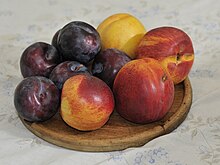Prunus subg. Prunus is a subgenus of Prunus. This subgenus includes plums, apricots and bush cherries. Some species conventionally included in Prunus subg. Amygdalus are clustered with plum/apricot species according to molecular phylogenetic studies.[1][2] Shi et al. (2013) has incorporated subg. Amygdalus into subg. Prunus, thereby including almonds and peaches in this subgenus.[1] The species in this subgenus have solitary flowers or 2–3 in a fascicle.[1][3]
| Prunus subg. Prunus | |
|---|---|
 | |
| Plums and nectarines | |
| Scientific classification | |
| Kingdom: | Plantae |
| Clade: | Tracheophytes |
| Clade: | Angiosperms |
| Clade: | Eudicots |
| Clade: | Rosids |
| Order: | Rosales |
| Family: | Rosaceae |
| Genus: | Prunus |
| Subgenus: | Prunus subg. Prunus |
| Section | |
See text. | |
Sections according to Shi et al. (2013)
Shi et al. (2013) divide subg. Prunus into seven sections: sect. Amygdalus, sect. Armeniaca, sect. Emplectocladus, sect. Microcerasus, sect. Persicae, sect. Prunocerasus and sect. Prunus. They form three clades. The basal clade is sect. Emplectocladus which is sometimes treated as a subgenus. The other two clades are the Amygdalus-Persicae clade (sometimes treated as subg. Amygdalus) and the Armeniaca-Microcerasus-Prunocerasus-Prunus clade (subg. Prunus in a narrow sense).[1]
Sect. Emplectocladus
Prunus sect. Emplectocladus (Torr.) A.Gray is the sister group to all the other species in this subgenus,[1] and sometimes treated as a distinct subgenus, Prunus subg. Emplectocladus (Torr.) S.C.Mason. It includes six New World species.[4][5]
- Prunus fasciculata – desert almond
- Prunus cercocarpifolia
- Prunus eremophila – Mojave Desert almond
- Prunus havardii – Havard's wild almond
- Prunus microphylla – Mexican wild almond
- Prunus minutiflora – Texas wild almond
Sect. Amygdalus & Sect. Persica
Prunus sect. Amygdalus (L.) Benth. & Hook.f. and Prunus sect. Persica (Mill.) Nakai[a] sometimes constitute Prunus subg. Amygdalus (L.) Focke. They form a monophyletic clade together, but the boundary between them seems not very distinct. A few species, such as P. spinosissima (thorny almond) and P. kansuensis (Gansu peach), are clustered in either sect. Amygdalus or sect. Persica in different studies.[2][6] The word "ămygdălus" is Latin for the almond nut.[7]
Sect. Amygdalus includes most Old World almond species except P. mongolica, P. tangutica, P. triloba, P. pedunculata, P. tenella, P. petunnikowii and probably other related species.[2]
Selected species:
- Prunus arabica – Arabian wild almond
- Prunus dulcis – almond
- Prunus fenzliana
- Prunus spinosissima – thorny almond
Sect. Persica includes peach species[8] as well as two species previously considered almonds (P. mongolica and P. tangutica).[2]
- Prunus davidiana – Chinese peach
- Prunus ferganensis – Fergana peach
- Prunus kansuensis – Gansu peach
- Prunus mira – Tibetan peach
- Prunus mongolica – Mongolian almond
- Prunus persica – peach
- Prunus tangutica – Tangut almond
Sect. Armeniaca
Species in this Prunus sect. Armeniaca (Scop.) Koch are apricots, native to Eurasia.[1]
Selected species:
- Prunus armeniaca – apricot
- Prunus mandshurica – Manchurian apricot
- Prunus mume – Japanese apricot
- Prunus sibirica – Siberian apricot
Sect. Microcerasus
Species in Prunus sect. Microcerasus (Webb & Berthel.) C.K.Schneid. are known as bush cherries or dwarf cherries.[1]
Selected species:
Sect. Prunocerasus
Prunus sect. Prunocerasus Koehne includes New World plums and peachbush (P. texana).[2][1]
Selected species:
- Prunus americana – American plum
- Prunus angustifolia – sand plum
- Prunus maritima – beach plum
- Prunus mexicana – Mexican plum
- Prunus nigra – Canada plum
- Prunus texana – peachbush
Sect. Prunus
Prunus sect. Prunus includes Old World plums.[1]
Selected species:
- Prunus cerasifera – cherry plum
- Prunus domestica – European plum
- Prunus salicina – Chinese plum
- Prunus simonii – apricot plum
- Prunus spinosa – sloe
Additional sections
Species of the following sections were not presented in the results of Shi et al. (2013). Therefore, their relationship with the sections proposed by Shi et al. (2013) is unclear.
Sect. Chamaeamygdalus
Prunus sect. Chamaeamygdalus (Spach) Dippel used to be included in the Amygdalus-Persica clade. However, molecular phylogenetic research indicates that it should be excluded from the Amygdalus-Persica clade.[2] The phylogenetic positions of the species in this section are still uncertain.
- Prunus tenella – Russian almond
- Prunus petunnikowii
Sect. Louiseania
Prunus sect. Louiseania (Carrière) Yazbek includes two or three Asian species.[9] Although they are called flowering almond, they are more related to bush cherries (sect. Microcerasus) and apricots (sect. Armeniaca).[2][6][10][11][12][13][14][15][16] According to nuclear phylogenomic analyses, the type species of sect. Louiseania, P. triloba, is embedded in sect. Microcerasus and closely related to the P. prostrata, the type species of sect. Microcerasus. However, in the phylogenetic tree based on plastid genome, P. triloba together with P. tomentosa (also a member of sect. Microcerasus) and apricots is in a clade that is sister to the core part of sect. Microcerasus.[14][16]
Sect. Penarmeniaca
Prunus sect. Penarmeniaca S.C.Mason is the sister group to New World plums, P. texana and probably the Old World species P. tenella.[2] It includes two New World species.[4][17]
- Prunus andersonii – desert peach
- Prunus fremontii – desert apricot